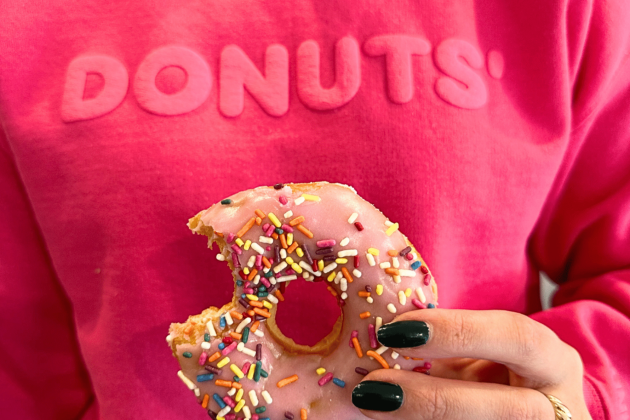Dunkin’ Donuts Serves up Apparel, April Fool’s Day Name and Supposedly 5,000 Coffee Choices

After five years of being on a first-name basis with customers, Dunkin’ changed its name for a day to “Donuts.”
Quite the April Fool’s Day prank, the Canton, Mass.-based coffee and donut chain has launched a limited-run of apparel. After being known as Dunkin’ Donuts for decades, the company retooled its name to just “Dunkin'” five years ago. In an Instagram post on April 1, Dunkin’ explained “we’re changing our name again. now we’re just DONUTS’. we will have coffee still. pls. don’t ask any other questions. just going thru it rn. -DONUTS’.”
More from WWD
A Dunkin’ publicist emailed WWD Monday morning to say, “The brand has decided to go back to its roots and rebrand to just Donuts’… today, April 1st.” Asked to confirm that the rebrand was not an April Fool’s Day joke, she wrote, “The merch is very real. The brand name change to donuts won’t stick past tomorrow ?? but donuts merch is real!”
Shoppers may want to snatch up this drop, because just like with the jelly, glazed and Boston crème doughnuts that are sold every day in its stores, once they are gone — that’s it for the day. Dunkin’ followers learned of it via Instagram, TikTok and X. Tonal crewneck sweatshirts imprinted with “DONUTS” are being offered in beige, white and Dunkin’ Donuts signature pink. The company first favored that “Barbie”-friendly pink as part of a redesign in 1960 — long before Barbiecore emerged or Pantone released a Barbie pink.
The name Dunkin’ Donuts was hatched in 1950, two years after founder William Rosenberg had unveiled a coffee and doughnut shop outside of Boston. Corporate lore attributes the name change to an executive architect, who was inspired by the idea of dunking doughnuts into coffee.
Anticipating a hot item — and inevitably a data-harvesting opportunity for thousands of new customers, visitors to the Dunkin’s e-commerce site require a password to access the limited-edition apparel. Like the chain’s affordable doughnuts, the apparel is within reach too — with sweatshirts selling for $25 plus shipping and handling. Although consumers have 5,000 different options for ordering a coffee at Dunkin’ or “Donuts'” — according to its site, the branded clothing is considerably more restricted. And although the company has 12,500 locations in 46 countries, the “DONUTS” apparel is only available to those in the U.S.
In recent years, doughnut shops have been a culinary trend in New York and other foodie-loving cities. Artisanal ones are of particular interest with Dough, Doughnut Plant, Fan Fan Donuts, Bear, Doughnut Project and Daily Provisions giving the indulgence an upgrade. Designers like Tom Ford and Vera Wang don’t need convincing — each has shared their fondness for doughnuts publicly. Ford reportedly claimed to eat one a day, although his physique suggests otherwise. During New York Fashion Week, some designers lace their backstage catering with doughnuts for models, who presumably hold off until after the show.
Dunkers, sinkers, crullers — however you define them — doughnuts ring up an estimated $3.6 billion worth of business annually in the U.S. For a “National Donut Day” article in WWD, Dunkin’ Donuts created a one-off Chanel-inspired doughnut with a strawberry-frosted doughnut with sprinkles that was redesigned to be reminiscent of the luxury house’s signature interlocking “C’s.”
The high-low appeal of doughnuts is not new, though. In 1903, Isabella Stewart Gardner served Champagne and doughnuts as refreshments after the Boston Symphony performed at the black tie unveiling of her Italian palazzo art museum. That combination prompted one guest — Edith Wharton — to compare the choice to being fit for a provincial train station in France. Leaving the party, Gardner, who unbeknownst to Wharton spoke French and had heard the slight, offered a sign of thanks before telling Wharton she needn’t expect another invitation to eat in this railroad station.
Best of WWD